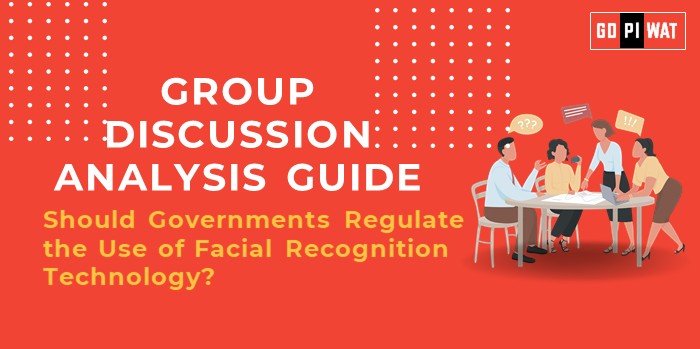📋 Group Discussion (GD) Analysis Guide
📸 Topic: Should Governments Regulate the Use of Facial Recognition Technology?
🌐 Introduction
Facial recognition technology (FRT) is revolutionizing industries worldwide, from streamlining airport operations to aiding law enforcement. However, its rapid adoption raises critical concerns about privacy, data security, and ethical use, urging governments to establish robust regulations that balance innovation with societal trust.
📊 Quick Facts & Key Statistics
- 🌍 Global Market Size: Valued at USD 5.15 billion in 2022, projected to grow at a CAGR of 14.9% from 2023 to 2030.
- ⚖️ Accuracy Disparities: Studies reveal higher misidentification rates for women and people of color, highlighting systemic bias.
- 🇮🇳 Adoption in India: Initiatives like Digi Yatra improve airport efficiency, and FRT is increasingly integrated into law enforcement systems.
- 🇪🇺 EU Stance: The Artificial Intelligence Act classifies FRT as “high risk,” necessitating strict compliance measures.
- 🔒 Cyber Threats: Biometric data breaches, such as incidents involving Indian law enforcement officials, expose security vulnerabilities.
🤝 Stakeholders and Their Roles
- 🏛️ Governments: Draft and enforce ethical regulations for FRT use.
- 💻 Tech Companies: Develop and deploy FRT solutions while addressing bias and security concerns.
- 🌍 Civil Society: Advocate for privacy and human rights in the deployment of FRT.
- 📜 Global Organizations: Set international guidelines for responsible FRT use.
- 👥 Citizens: Participate in informed discussions and advocate for balanced FRT policies.
🏆 Achievements and Challenges
- Achievements:
- ✅ Streamlined Operations: Digi Yatra improves passenger processing at airports.
- 🕵️ Crime Solving: Law enforcement uses FRT to identify suspects and locate missing individuals.
- 📈 Economic Growth: FRT’s market expansion fosters innovation and job creation.
- Challenges:
- ⚠️ Privacy Concerns: Surveillance misuse threatens individual freedoms.
- 📊 Bias Issues: Systemic errors disproportionately affect marginalized groups.
- 🔓 Cybersecurity: Biometric data breaches highlight system vulnerabilities.
🌍 Global Comparisons
- 🇪🇺 European Union: Implements ethical frameworks under the Artificial Intelligence Act.
- 🇨🇳 China: Expansive use in surveillance but faces global criticism for lack of privacy safeguards.
Case Study: India’s Digi Yatra initiative demonstrates FRT’s potential for improving passenger experiences while emphasizing the need for stringent security measures.
🧠 Effective Discussion Approaches
- Opening Approaches:
- 📈 Data-Driven: “With a market valuation of USD 5.15 billion, FRT is poised to reshape industries while demanding ethical regulation.”
- 📋 Example-Based: “India’s Digi Yatra initiative highlights FRT’s potential alongside its security challenges.”
- Counter-Argument Handling:
- 🎯 Acknowledge limitations like bias but propose solutions such as algorithmic improvements.
- 🤝 Advocate for partnerships between governments and tech firms to ensure equitable implementation.
🔍 Strategic Analysis of Strengths & Weaknesses
- Strengths: Enhances operational efficiency; supports law enforcement; drives economic growth.
- Weaknesses: Risks of privacy invasion; systemic biases; data security vulnerabilities.
- Opportunities: Ethical frameworks and global leadership in regulating advanced technologies.
- Threats: Public distrust and misuse by authoritarian regimes.
📄 Structured Arguments for Discussion
- ✅ Supporting Stance: “FRT regulation ensures responsible deployment while protecting citizen privacy.”
- ❌ Opposing Stance: “Overregulation risks stifling technological progress and economic growth.”
- ⚖️ Balanced Perspective: “Governments should regulate FRT to safeguard rights without hindering innovation.”
📚 Connecting with B-School Applications
- 💼 Real-World Applications: Ethical AI practices in corporate governance, innovation management, and policy analysis.
- 📝 Sample Interview Questions:
- 📌 “What role should governments play in regulating emerging technologies like FRT?”
- 📌 “How can businesses balance innovation with privacy in FRT implementation?”
- 💡 Insights for Students: Explore intersections of technology policy, ethics, and innovation for future consulting or entrepreneurial roles.


